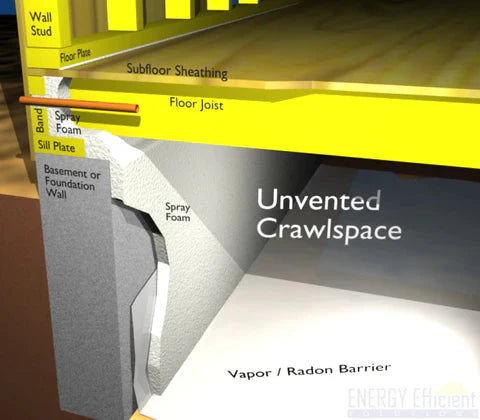The steps below outline how to convert a crawlspace from an inefficient vented space to a sealed and insulated (unvented) space. Insulating crawl spaces addresses the inefficiencies and moisture problems that exist in many vented crawlspaces.
STEP 1: Check for Excessive Moisture
If you have excessive moisture such as puddles or standing water in your crawlspace, an unvented crawlspace may not be the best approach for your situation. In this case it is advisable to consult with a professional in your local area prior to converting your crawlspace.
CONDENSATION
In some cases excess moisture can be introduced through the same vents intended to relieve moisture. This can be especially problematic during summer months in warm humid climates. Regulated by the ground, crawlspace temperatures can be 20 degrees or more below the outdoor temperature. As warm humid outside air comes in, it cools to the crawlspace temperature. Since the ability of air to hold moisture decreases as its temperature decreases, the moisture in the air condensates onto the cooler surfaces in the crawlspace. You may notice drops of water on the underside of the floor, joists, supports or even on the ground. The vents intended to relieve moisture are actually causing this problem and if left unaddressed will result in mold, rot, or other damage.
STEP 2: Install a Vapor Barrier over the Ground
In this step you will seal off the ground to prevent moisture and any harmful gases, such as radon, from entering the crawlspace through the soil.
VAPOR BARRIER
Use a quality vapor barrier such as ARMA FOIL-VB or 6 mil plastic to cover the ground. Overlap each sheet by roughly 6" and seal the seams with a high quality tape or glue. Allow enough excess to wrap and extend the vapor barrier up the foundation wall by roughly 12 inches. Adhere the vapor barrier to the foundation wall with glue, caulk, or foam.

STEP 3: Seal and Insulate the Foundation Wall
Closed Cell foam will both seal and insulate your foundation wall. In addition, using spray foam insulation on crawl spaces adds a moisture barrier to help keep moisture from wicking through the stone or concrete.
INSULATING CRAWL SPACE WALLS
Check your particular climate zone to determine how much foundation insulation coating should be applied to your crawl space walls. Use foam board or plywood to cover over any existing vents. Apply a layer of closed cell foam to coat the entire foundation wall from the crawlspace side. Ensure that the foam overlaps the vapor barrier extending partially up the wall.
Spray Foam Kits | Spray Foam Safety Kit

STEP 4: Seal and Insulate Rim Joists
The final step is to seal and insulate the Band/Rim Joists with the help of a DIY crawl space encapsulation kit with the help of a DIY crawl space encapsulation kit.
BEFORE
Prior to sealing and insulating the band joists, air and moisture are introduced through a variety of problem areas. Click on the image to the right to see a larger, detailed version.
- Unsealed - Air leaks through all the cracks between framing members and penetrations for plumbing and wires. Air leakage accounts for about 40% of the heat lost in a typical building. In addition small pests and insects often find their way in.
- Uninsulated - Heat from your basement or unvented crawlspace is lost through uninsulated rim joists.
- Condensation - Moisture condenses on the cold surfaces of rim joists leading to mold and rot.

Common sources of air leakage through and around rim joists.
AFTER
Fortunately, all of the above problems can be addressed with one easy solution. Just apply closed cell spray foam over this entire area. Be sure to cover all seams to air seal and coat the band joist with 1-2 inches of crawl space spray insulation foam. Closed cell crawl space foam insulation also creates a moisture barrier and helps prevent condensation.

Cross sectional view of a rim joist after being sealed and insulated with foam.
Benefits:
There are a few additional benefits of using foundation spray foam insulation in unvented crawl spaces.
- Reduced Pests - Completely sealing the crawlspace reduces the ability for pests to enter the space.
- Saved Energy (infiltration) - Air sealing the crawlspace reduces air leakage into or out of your home above.
- Saved Energy (conductive) - A sealed and insulated crawlspace will remain at a much closer temperature to the inside of your house. This in turn reduces heat lost or gain through the floor saving energy.
- Lowered Chance of Freezing Pipes - A sealed and insulated crawlspace will keep a higher temperature in the winter lowering the chance of frozen pipes.
- Less Condensation - Sealing the ground and eliminating outdoor air removes the most common sources of moisture entering the crawlspace.








